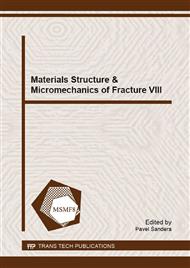p.546
p.550
p.554
p.558
p.562
p.566
p.570
p.574
p.579
Static Tensile Strength and E-Modulus Evaluation of a High-Strength Reinforcing Textile Fabrics
Abstract:
An experimental approach developed and used for an evaluation of basic static mechanical properties of textile fabric with predominantly longitudinal orientation of yarns, namely static strength and elastic modulus, is described in the paper. The fabric was made using yarns of a dark colour, but no further details were available. Attempts to test just the fabric were not successful and valid due to problems with gripping. Therefore, thin composite plates made of the fabric as the main constituent were sectioned and longitudinal strips were statically loaded with strain measurement. To evaluate the elastic modulus and strength of the fabric in itself, the following steps were performed: (i) cross section area of the strips was evaluated using optical microscope considering effects of the corrugated specimen surface, (ii) area of resin and pores between the yarns was eliminated using Quick PHOTO Industrial 2.3 software and eventually (iii) total cross section of fibres within the yarns was estimated on the basis of closest arrangement assumption. The results are presented and discussed from the viewpoint of a possible aramid type.
Info:
Periodical:
Pages:
562-565
Citation:
Online since:
December 2016
Authors:
Keywords:
Price:
Сopyright:
© 2017 Trans Tech Publications Ltd. All Rights Reserved
Share:
Citation:


